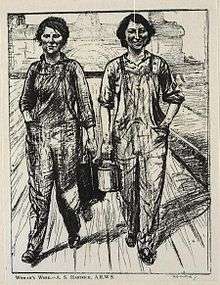Archibald Standish Hartrick
| A.S. Hartrick | |
|---|---|
| Born |
7 August 1864 Bangalore |
| Died |
1 February 1950 (aged 85) London |
| Nationality | British |
| Education | |
| Known for | Painting, drawing |
Archibald Standish Hartrick RWS OBE (7 August 1864 – 1 February 1950) was a Scottish painter known for the quality of his lithographic work. His works covered urban scenes, landscapes and figure painting and he was a founder member of the Senefelder Club.[1]
Life and work

Hartrick was born in Bangalore, the son of an officer in the British Army. The family moved to Scotland when Hartrick was two years old. His father died shortly afterwards and in due course his mother married Charles Blatherwick, a doctor and keen amateur watercolourist who had been involved in the establishment of the Royal Scottish Society of Painters in Watercolour.[2] After attending Fettes College,[3] Hartrick studied medicine at Edinburgh University before studying art at the Slade School of Art in London and then at both the Academie Julian and the Atelier Cormon in Paris.[4] Hartrick spent the summer of 1886 at Pont-Aven with Paul Gauguin. In Paris he had become friends with Vincent van Gogh and Toulouse-Lautrec and exhibited a work at the Paris Salon in 1887.[5]
Hartrick returned to Scotland and for a while settled in Glasgow, where he came to know the Glasgow Boys, before he moved to London. There he began work as a book illustrator and as an illustrator with The Graphic in 1890, then with the Pall Mall Magazine in 1893.[2] He joined the New English Art Club the same year.[6] In 1896 he married the painter Lily Blatherwick, the daughter of Charles Blatherwick from his first marriage. The couple settled in Tresham in Gloucestershire, from where they both pursued their artistic careers; they both had works shown at the Continental Gallery in 1901. Hatrick and his wife later redecorated the small church in Tresham and she is buried in the graveyard there.[7] Hartrick moved to London, where he taught drawing at the Camberwell School of Art from 1908 to 1914 and later at the Central School of Art, where he taught lithography until 1929.[2] In 1909 Hartrick was among the founding members of the Senefelder Club. In 1910 Hartrick was elected an associate member of the Royal Watercolour Society and became a full member in 1920.[8] Eventually Hartrick had over 200 works shown at the Royal Watercolour Society and he also exhibited at the Venice Biennale on three occasions.[9] A series of his works showing rural characters, entitled Cotswold Types was acquired by the British Museum.[1]
During the First World War, Hartrick contributed works to the British War Memorials Committee collection of artworks. In 1917 Hartrick produced six lithographs on Women's Work for the War Propaganda Bureau's Britain's Efforts and Ideals portfolio of images which were exhibited in Britain and abroad and were also sold as prints to raise money for the war effort.[10] At the start of the Second World War, he was among the first to offer his services to the War Artists' Advisory Committee. In 1940 he was the first artist commissioned to record the work of the Women's Land Army, the same subject he had covered in World War One. Prints of his work were sold in at the National Gallery during the war and featured in the Britain at War exhibition that opened at the Museum of Modern Art in New York in May 1941.[11][12] During the war, Hatrick also painted scenes near his former home at Tresham in Gloustershire for the Recording Britain scheme.[7] The Arts Council organized a memorial exhibition for Hartrick in 1951.[5]
Bibliography
- 1916: Post-impressionism, with some personal recollections of Vincent Van Gogh & Paul Gauguin[8]
- 1932: Lithography as a Fine Art
- 1939: A Painter's Pilgrimage through Fifty Years.[5]
References
- 1 2 Peter J.M. McEwan (1994). The Dictionary of Scottish Art and Architecture. Antique Collectors' Club. ISBN 1 85149 134 1.
- 1 2 3 Paul Harris & Julian Halsby (1990). The Dictionary of Scottish Painters 1600 to the Present. Canongate. ISBN 1 84195 150 1.
- ↑ Gill Clarke (2008). The Women's Land Army A Portrait. Sansom & Company. ISBN 978-1-904537-87-8.
- ↑ Frances Spalding (1990). 20th Century Painters and Sculptors. Antique Collectors' Club. ISBN 1 85149 106 6.
- 1 2 3 David Buckman (1998). Artists in Britain Since 1945 Vol 1, A to L. Art Dictionaries Ltd. ISBN 0 95326 095 X.
- ↑ Tate. "Artist biography: A.S. Hartrick". Tate. Retrieved 14 April 2014.
- 1 2 Gill Saunders (Editor) (2011). Recording Britain. V&A Publishing. ISBN 978-1-85177-661-0.
- 1 2 Martin Bailey (2001). "Memories of Van Gogh and Gauguin: Hartrick's reminiscences". Van Gogh Museum Journal. Retrieved 16 April 2014.
- ↑ British Council. "British Council Collection Hartrick". British Council. Archived from the original on 16 April 2014. Retrieved 14 April 2014.
- ↑ Mari Gordon (Series Editor) (2014). The Great War: Britain's Efforts and Ideals. National Museum of Wales. ISBN 9780720006278.
- ↑ Imperial War Museum. "War artist archive -A.S. Hartrick". Imperial War Museum. Retrieved 14 April 2014.
- ↑ Brain Foss (2007). War paint: Art, War, State and Identity in Britain, 1939-1945. Yale University Press. ISBN 978-0-300-10890-3.
External links
- 5 Painting(s) by or after Archibald Standish Hartrick at the Art UK site